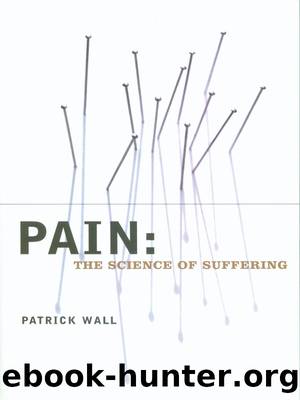Pain by Patrick Wall

Author:Patrick Wall
Language: eng
Format: epub
Tags: Medical/Neuroscience
Publisher: Columbia University Press
Published: 2011-09-09T16:00:00+00:00
Trigeminal Neuralgia
We will start with a fairly rare condition that causes severe pain so specific that one would think that there must be a local pathology, and yet none has been discovered. Tic douloureux, as trigeminal neuralgia is also known, is a terrible pain in the face with stabbing pain on one side often described as a strong electric shock. Between the attacks, the patient is pain free and normal. The pain comes on abruptly and stops equally abruptly. The pain explodes if a gentle moving stimulus brushes a trigger point, usually in the area around the mouth. It occurs equally in men and women and is most common between the ages of fifty to seventy years but may occur at any age. If nothing is done, the pain may disappear for months or years only to reappear in the same area. The little trigger point that sets off the stab of pain may meander slowly from one part of the face to another.
It would seem entirely reasonable to patient and doctor that there must be some damage to the nerve fibers leading from the trigger point to the brain. However, this is not so reasonable when we consider the following facts. The nerves in the face have been examined in great detail and no abnormality has been found. The sensitivity of the skin of the trigger point is completely normal between attacks, and, yet, if nerves are damaged, one would expect abnormal sensation. Finally, as we have said, the trigger point meanders about while nerves remain in the same place for a lifetime.
The nerves from the face originate from cells in a ganglion in the base of the skull that is the equivalent of the dorsal root ganglia that lie on either side of the vertebrae and give rise to sensory nerves to the body. From the ganglion, the nerve fibers group into a root, which makes its way into the brainstem where the fibers connect with central nerve cells. The root runs free in the fluid around the brain. One theory proposes that the nerves are damaged by being pounded with pulses from nearby blood vessels. There may be some sign of minor damage, but just such damage is present in many people who have no signs of the disease. In the brainstem, there are no signs of damage in most patients, but some patients, who have multiple sclerosis in the brainstem area where the face nerve fibers arrive, do develop tic.
Fortunately for patients, two methods of treatment are used, and they tell us a lot about the nature of the disorder. The French word tic means a “twitch” and is also used for an epileptic attack. With no more logic than the similar use of the word for both conditions, antiepileptic drugs were given to patients with trigeminal neuralgia and found to be highly effective in the majority of patients. This is good for the patients but shifts the search for the cause of the disease. These
Download
This site does not store any files on its server. We only index and link to content provided by other sites. Please contact the content providers to delete copyright contents if any and email us, we'll remove relevant links or contents immediately.
When Breath Becomes Air by Paul Kalanithi(7264)
Why We Sleep: Unlocking the Power of Sleep and Dreams by Matthew Walker(5642)
Paper Towns by Green John(4169)
The Immortal Life of Henrietta Lacks by Rebecca Skloot(3826)
The Sports Rules Book by Human Kinetics(3588)
Dynamic Alignment Through Imagery by Eric Franklin(3489)
ACSM's Complete Guide to Fitness & Health by ACSM(3469)
Kaplan MCAT Organic Chemistry Review: Created for MCAT 2015 (Kaplan Test Prep) by Kaplan(3423)
Introduction to Kinesiology by Shirl J. Hoffman(3301)
Livewired by David Eagleman(3122)
The River of Consciousness by Oliver Sacks(2992)
Alchemy and Alchemists by C. J. S. Thompson(2911)
The Death of the Heart by Elizabeth Bowen(2901)
Descartes' Error by Antonio Damasio(2731)
Bad Pharma by Ben Goldacre(2730)
Kaplan MCAT Behavioral Sciences Review: Created for MCAT 2015 (Kaplan Test Prep) by Kaplan(2492)
The Gene: An Intimate History by Siddhartha Mukherjee(2491)
The Fate of Rome: Climate, Disease, and the End of an Empire (The Princeton History of the Ancient World) by Kyle Harper(2436)
The Emperor of All Maladies: A Biography of Cancer by Siddhartha Mukherjee(2431)
